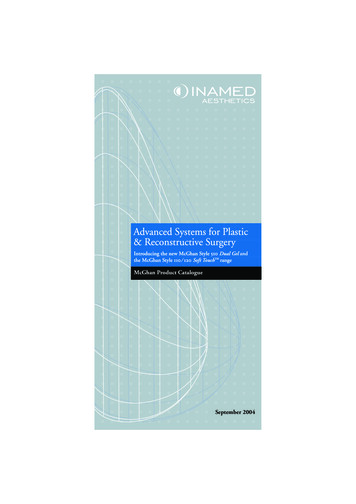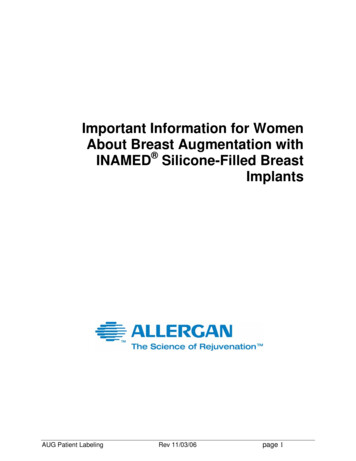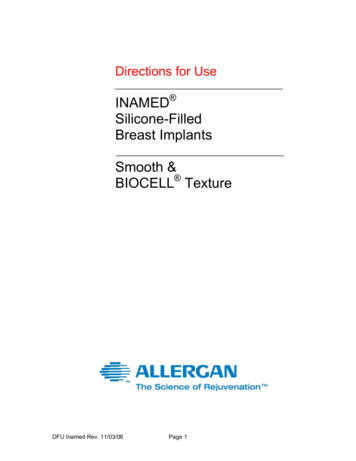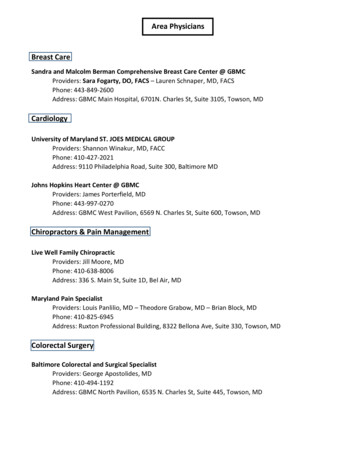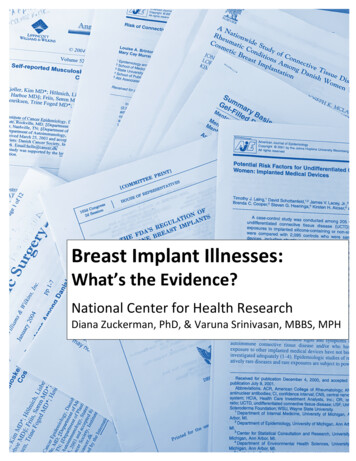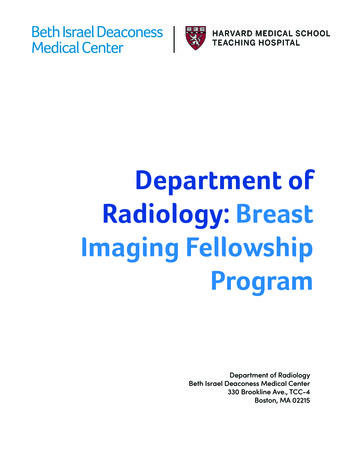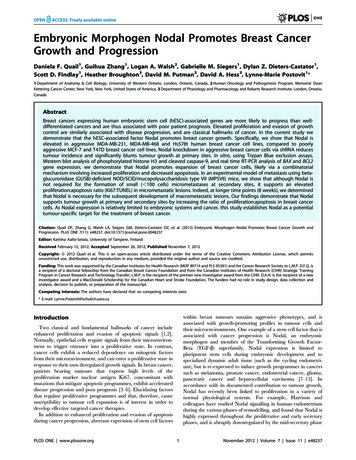
Transcription
Embryonic Morphogen Nodal Promotes Breast CancerGrowth and ProgressionDaniela F. Quail1, Guihua Zhang1, Logan A. Walsh2, Gabrielle M. Siegers1, Dylan Z. Dieters-Castator1,Scott D. Findlay1, Heather Broughton3, David M. Putman3, David A. Hess3, Lynne-Marie Postovit1*1 Department of Anatomy & Cell Biology, University of Western Ontario, London, Ontario, Canada, 2 Human Oncology and Pathogenesis Program, Memorial SloanKettering Cancer Center, New York, New York, United States of America, 3 Department of Physiology and Pharmacology and Robarts Research Institute, London, Ontario,CanadaAbstractBreast cancers expressing human embryonic stem cell (hESC)-associated genes are more likely to progress than welldifferentiated cancers and are thus associated with poor patient prognosis. Elevated proliferation and evasion of growthcontrol are similarly associated with disease progression, and are classical hallmarks of cancer. In the current study wedemonstrate that the hESC-associated factor Nodal promotes breast cancer growth. Specifically, we show that Nodal iselevated in aggressive MDA-MB-231, MDA-MB-468 and Hs578t human breast cancer cell lines, compared to poorlyaggressive MCF-7 and T47D breast cancer cell lines. Nodal knockdown in aggressive breast cancer cells via shRNA reducestumour incidence and significantly blunts tumour growth at primary sites. In vitro, using Trypan Blue exclusion assays,Western blot analysis of phosphorylated histone H3 and cleaved caspase-9, and real time RT-PCR analysis of BAX and BCL2gene expression, we demonstrate that Nodal promotes expansion of breast cancer cells, likely via a combinatorialmechanism involving increased proliferation and decreased apopotosis. In an experimental model of metastasis using betaglucuronidase (GUSB)-deficient NOD/SCID/mucopolysaccharidosis type VII (MPSVII) mice, we show that although Nodal isnot required for the formation of small (,100 cells) micrometastases at secondary sites, it supports an elevatedproliferation:apoptosis ratio (Ki67:TUNEL) in micrometastatic lesions. Indeed, at longer time points (8 weeks), we determinedthat Nodal is necessary for the subsequent development of macrometastatic lesions. Our findings demonstrate that Nodalsupports tumour growth at primary and secondary sites by increasing the ratio of proliferation:apoptosis in breast cancercells. As Nodal expression is relatively limited to embryonic systems and cancer, this study establishes Nodal as a potentialtumour-specific target for the treatment of breast cancer.Citation: Quail DF, Zhang G, Walsh LA, Siegers GM, Dieters-Castator DZ, et al. (2012) Embryonic Morphogen Nodal Promotes Breast Cancer Growth andProgression. PLoS ONE 7(11): e48237. doi:10.1371/journal.pone.0048237Editor: Katriina Aalto-Setala, University of Tampere, FinlandReceived February 12, 2012; Accepted September 26, 2012; Published November 7, 2012Copyright: ß 2012 Quail et al. This is an open-access article distributed under the terms of the Creative Commons Attribution License, which permitsunrestricted use, distribution, and reproduction in any medium, provided the original author and source are credited.Funding: This work was supported by the Canadian Institutes for Health Research (MOP 89714 and PLS 95381) and the Cancer Research Society to L.M.P. D.F.Q. isa recipient of a doctoral fellowship from the Canadian Breast Cancer Foundation and from the Canadian Institutes of Health Research (CIHR) Strategic TrainingProgram in Cancer Research and Technology Transfer. L.M.P. is the recipient of the premier new investigator award from the CIHR. D.A.H. is the recipient of a newinvestigator award and a MacDonald Scholarship for the Canadian Heart and Stroke Foundation. The funders had no role in study design, data collection andanalysis, decision to publish, or preparation of the manuscript.Competing Interests: The authors have declared that no competing interests exist.* E-mail: Lynne.Postovit@schulich.uwo.cawithin breast tumours sustains aggressive phenotypes, and isassociated with growth-promoting profiles in tumour cells andtheir microenvironments. One example of a stem cell factor that isassociated with cancer progression is Nodal, an embryonicmorphogen and member of the Transforming Growth FactorBeta (TGF-b) superfamily. Nodal expression is limited topluripotent stem cells during embryonic development and tospecialized dynamic adult tissue (such as the cycling endometrium), but is re-expressed to induce growth programmes in cancerssuch as melanoma, prostate cancer, endometrial cancer, glioma,pancreatic cancer and hepatocellular carcinoma [7–15]. Inaccordance with its documented contribution to tumour growth,Nodal has recently been linked to proliferation in a variety ofnormal physiological systems. For example, Harrison andcolleagues have studied Nodal signalling in human endometriumduring the various phases of remodelling, and found that Nodal ishighly expressed throughout the proliferative and early secretoryphases, and is abruptly downregulated by the mid-secretory phaseIntroductionTwo classical and fundamental hallmarks of cancer includeenhanced proliferation and evasion of apoptotic signals [1,2].Normally, epithelial cells require signals from their microenvironment to trigger entrance into a proliferative state. In contrast,cancer cells exhibit a reduced dependence on mitogenic factorsfrom their microenvironment, and can enter a proliferative state inresponse to their own deregulated growth signals. In breast cancer,patients bearing tumours that express high levels of theproliferation marker nuclear antigen Ki67, concomitant withmutations that mitigate apoptotic programmes, exhibit accelerateddisease progression and poor prognosis [3–6]. Elucidating factorsthat regulate proliferative programmes and that, therefore, causesusceptibility to tumour cell expansion is of interest in order todevelop effective targeted cancer therapies.In addition to enhanced proliferation and evasion of apoptosisduring cancer progression, aberrant expression of stem cell factorsPLOS ONE www.plosone.org1November 2012 Volume 7 Issue 11 e48237
Nodal and Breast Cancer Growthselectively inhibits Activin, TGF-b and Nodal signalling but notBMP signalling. In addition, SB431542 does not affect components of the ERK, JNK, or p38 MAP kinase pathways [22].[13]. In addition, Salomon and colleagues have found that Nodaland members of the Nodal signalling pathway are cyclicallyexpressed during mammary gland remodelling. In particular,Nodal, Cripto, ALK4, and SMAD4 are upregulated duringlactational expansion of alveolar epithelial tissue, and downregulated during involution (marked by widespread apoptosis) in BalbCmice [16,17]. Together, these studies suggest that Nodal may playa role in promoting proliferative phenotypes in dynamic epithelialcell types.A recent study reported that Nodal is positively correlated withdisease progression in breast cancer patients, such that it isexpressed to a higher level in poorly differentiated, invasive lesionsas compared to benign and early stage disease [18]. This studyfurther demonstrated that inhibition of Nodal signalling inaggressive breast cancer cell lines reduces proliferation andinduces apoptosis in vitro [18]. In addition, transient inhibition ofNodal in MDA-MB-231 breast cancer cells with Morpholinooligonucleotides has been shown to delay tumourigenesis in nudemice, concomitant with reduced proliferation (by Ki67 staining)and elevated apoptosis (by TUNEL staining) [19]. It is not known,however, if these trends extend to gain-of-function models or ifNodal supports breast cancer growth at both primary andsecondary sites.Here, we demonstrate that stable Nodal knockdown significantly blunts tumour growth in an orthotopic mouse model oftumourigenesis. In vitro, we confirmed that Nodal inhibition inaggressive breast cancer cell lines decreases proliferation whilstinducing apoptosis, and further demonstrated that inhibition of thetype 1 receptor (ALK4/7) similarly affects breast cancer proliferation. We also determined that Nodal over-expression increasesproliferation and decreases apoptosis in T47D cells which do notnormally express high levels of this protein. Lastly, using a uniqueexperimental metastasis assay, we found that although Nodal doesnot affect the number of micrometastases in the lung (i.e. seedingefficiency), it enhances proliferation:apoptosis ratios in micrometastases in favour of tumourigenic growth. Indeed, these experiments indicated that Nodal is required for growth progression tomacrometastases at secondary sites. Our findings demonstrate thatNodal mediates growth of breast cancer cell lines in vitro and atmultiple sites in vivo.RNA Extraction and RT-PCRRNA isolation was performed using the Perfect Pure RNAcultured cell kit (5 Prime), and DNAse was used to degradegenomic DNA. Reverse transcription was performed using 2 mg ofRNA and a High Capacity cDNA Reverse Transcription kit(Applied Biosystems). Real-time PCR was performed withTaqManH gene expression human primer/probe sets. For a listof primer/probes, see Table S1. For analysis of BAX and BCL2gene expression in response to treatments, Ct values werenormalized to HPRT1, and compared using the DDCt method.Variability in housekeeping gene expression across cell linesconfounded results obtained with real time-RT-PCR. Hence,semi-quantitative RT-PCR was used to measure Nodal receptorcomponents across breast cancer cell lines using H9 hESC mRNAas a positive control. For semiquantitative PCR, 1/20th of thecDNA reaction was used as template for amplification usingAmpliTaq GoldH 360 Master Mix (Applied Biosystems). Validatedprimer probes were used as described above. The loading controlHPRT1 was amplified with forward primer: 59-atggcgacccgcagccctgg-39, and reverse primer: 59-ctggcgatgtcaataggactccagatgtttcc-39. The following cycling conditions were used: 95u for30 sec, 55u (ALK4, ALK7, Cripto) or 64u (HPRT1) for 30 sec, and72u for 1 min. ALK4 and HPRT1 were subjected to 30 cycles.ALK7 and Cripto were subjected to 35 cycles.Western BlottingProtein lysates were prepared using Mammalian ProteinExtraction Reagent (M-PER; Thermo Scientific) and HaltProtease Inhibitor Cocktail (Thermo Scientific) as per manufacturer’s instructions. Equal amounts of protein were reduced andseparated by SDS-polyacrylamide gel electrophoresis, and transferred onto Immobilon-P membranes (Millipore). Membraneswere blocked in 5% milk, incubated with primary antibody,washed, and incubated with horseradish peroxidase-labelledsecondary antibody. For a list of primary antibodies see TableS2. Secondary antibodies were detected by enhanced chemiluminescence (Super Signal; Pierce). In accordance with previousstudies [9,11,23,24], three banding locations were detected forNodal: Pro-Nodal at ,39 kDa, pre-pro-Nodal at ,50 kDa, andmature Nodal at ,15 kDa. The 50 kDa species is highly variabledue to differences in post-translational modifications and proteinlysate handling, and the 15 kDa band is poorly abundant inprotein lysate. For consistency, we used the 39 kDa band to assessNodal expression in lysates and the 15 kDa band in conditionedmedium, as previously described [21,24].MethodsCell Lines and TreatmentsTwo well-differentiated, breast cancer cell lines (MCF-7 andT47D) and three poorly-differentiated, cell lines (MDA-MB-231,MDA-MB-468 and Hs578t) [20] were used. All cancer cell lineswere obtained from the American Type Culture Collection(ATCC) and were maintained as per instructions. The phenotypesof these cells were verified by ATCC in accordance with protocolsavailable on the ATCC website. To increase Nodal signalling, weused a Nodal expression vector (versus an empty pcDNA3.3vector; pcDNATM3.3-TOPOH cloning kit; Invitrogen) as previously described [21]. We also employed recombinant humanNodal (rhNodal; R&D). To decrease Nodal signalling, we usedNodal-targeted shRNAs (versus scrambled control shRNAs) aspreviously described [21]. Two Nodal-targeted shRNAs wereused, a HuSH-29mer (Id: GI311711; Origene) and a GIPZlentiviral shRNAmir (Id: V2LHS 155453; Open Biosystems) torule-out off-target effects. Transfection was performed with ArrestIn (Open Biosystems) or Lipofectamine (Invitrogen) as permanufacturer instructions. For stable selection, Puromycin (200–450 ng/mL) or Geneticin (G418; 800 ng/mL) was used. Toinhibit Nodal signalling, we also used SB431542. SB431542PLOS ONE www.plosone.orgTumour Assays in Nude MiceAll experiments involving animals were approved by the AnimalUse Subcommittee at the University of Western Ontario.Nodal loss-of-function flank tumour assay. MDA-MB468 cells were transfected with a Control HuSH shRNA, or aNodal-targeted HuSH shRNA. 2,500,000 cells in 100 mL ofRPMI Matrigel (1:1) were injected into the right flank of 6–8week old athymic Nude-Foxn1nu mice. Tumour measurementswere taken twice per week and a digital caliper was used tomeasure Length 6Width 6Depth of the tumour upon excision inorder to calculate volume.Nodal loss-of-function orthotopic tumour assay. MDAMB-231 cells were transfected with a Control GIPZ shRNA, or aNodal-targeted GIPZ shRNA. 500,000 cells in 50 mL of RPMI2November 2012 Volume 7 Issue 11 e48237
Nodal and Breast Cancer Growthdescribed using napthol AS-BI b-D-glucuronide (Sigma-Aldrich)substrate [25], and counterstained with haematoxylin. Metastasesthat were,100 cells were considered ‘micro’, while metastases thatwere.100 cells were considered ‘macro’. For each mouse organ,3–6 sections were acquired from evenly spaced areas through thetissue, and the average number of metastases per mouse organ wascalculated. The proliferation-to-apoptosis ratio was determined bycounting Ki67 and TUNEL positive nuclei in matched serialsections. Briefly, tissues were formalin-fixed and paraffin-embedded and immunohistochemical staining on this tissue wasconducted using a human-specific Ki67 antibody (Table S2) asper manufacturer suggestion. The DeadEnd colorimetric TUNELsystem (Promega) was used to measure apoptosis as perinstructions. The proliferation-to-apoptosis ratio was determinedby counting Ki67 and TUNEL positive nuclei in matched serialsections. At least 3 pairs of serial sections, evenly spaced throughthe tissue, were averaged per mouse to yield an averageproliferation-to-apoptosis score for that animal.were injected into the mammary fat pad via the nipples of 6–8week old athymic Nude-Foxn1nu mice. Tumour measurementswere taken as described above.In vitro Cell Growth CurvesCells were seeded into 6-well plates (100,000 cells/well) andcounted over 4 days. Media containing dead and alive cells wascollected. Attached cells were harvested using Trypsin, combinedwith media, spun down, and resuspended with Trypan Blue. ACountess automated cell counter (Invitrogen) was used to calculatetotal cell number, live cells, dead cells, and viability.Cell Trace Violet Proliferation AssaysCells were starved 21–22 hours and then labelled with 2.5 mM(T47D lines) or 5 mM (MDA-MB-231 lines) Cell Trace Violet(CTV, Invitrogen) as per the manufacturer’s instructions. Briefly,culture medium was removed from cells and replaced with CTVdiluted to 2.5 or 5 mM in pre-warmed phosphate-buffered saline(PBS). Cells were incubated 20 min at 37uC after which CTVsolution was removed and cells were washed twice with prewarmed complete medium and then left in fresh medium for 4–6days. Cells were harvested via trypsinization and then washed inFACS buffer (PBS 1% FBS 2 mM EDTA) before flow cytometric acquisition. Fluorescence-activated cell sorting (FACS) wasperformed on an LSRII (Becton Dickinson, Mississauga ON)calibrated with CaliBRITE Beads (Becton Dickenson, MississaugaON). Live cell singlets were gated based on forward and sidescatter properties. Analysis was performed using FlowJoß software(Tree Star, Ashland, OR, USA, Version 9.5.2).Statistical AnalysesStatistics were performed using SigmaStat (Dundas Software),and validated through the biostatistical support unit at theUniversity of Western Ontario. All parametric data was analysedusing a one-way ANOVA and a Tukey–Kramer ComparisonsPost-Hoc test. All non-parametric data was analyzed using anANOVA on Ranks followed by the Mann-Whitney rank-sum test,and expressed as median 6 interquartile range. A student’s t-testwas used to compare two items. All statistical tests were two-sided,and data were considered statistically significant at p,0.05.TUNEL StainingResults and DiscussionCells were grown on glass coverslips to ,50% confluence andthen fixed with 4% paraformaldehyde. The DeadEnd colorimetricTUNEL system (Promega) was used to measure apoptosis as perinstructions. The % TUNEL positive cells were determined bycounting the number of positive cells in 3 fields of view on eachslide taken at 40X. This number was divided by the total numberof cells in these fields. At least 4 slides were used per experimentalgroup.Expression of Nodal, ALK4, ALK7 and Cripto in BreastCancer Cell LinesThrough Western blot analyses, we determined that Nodalprotein is elevated in cell lysates and in conditioned media frompoorly-differentiated Hs578t, MDA-MB-231 and MDA-MB-468breast cancer cell lines compared to well-differentiated MCF-7and T47D cell lines (Fig. 1A,B). This is consistent with previousreports that show high Nodal expression in aggressive melanoma,prostate, and breast cancer cell lines compared to poorlyaggressive lines [7,9,11,18].Nodal signals through interactions with Cripto-1 and theActivin-Like Kinase type I (ALK4/7) and type II (ActRIIB)receptor complex. Activation of this receptor complex leads toSMAD2/3 phosphorylation, and subsequent induction of Nodaldependent gene expression [26]. It has been reported that Nodalreceptor components are expressed at varying levels in prostatecancer cell lines [27]. In order to ensure the breast cancer cell linesused in this study have the potential to respond to alterations inNodal, we measured the expression of the members of the Nodalreceptor complex. Accordingly, we determined that ALK andCripto protein are present in Hs578t, MDA-MB-231, MDA-MB468, T47D and MCF-7 breast cancer cell lines at varying levelsand that all of these cell lines express ALK4, ALK7 and CriptomRNA (Fig 1C,D). This suggests that these cell lines are able torespond to and carry out Nodal-induced signal transduction. Sincethey secrete higher levels of Nodal, we decided to use MDA-MB468 and MDA-MB-231 cells in our loss-of-function models; andbecause they secrete very low levels of Nodal, but still expressNodal receptors, we chose to use T47D cells to study how the upregulation of Nodal expression affects breast cancer cells.ImmuonofluorescenceCells were fixed with 4% paraformaldehyde, made permeablewith 20 mM Hepes, 0.5% TritonX-100 and blocked with serumfree protein block (DAKO). Primary antibodies were diluted inantibody dilutent (DAKO) to the concentrations outlined inTable S2, and appropriate fluorochrome-conjugated secondaryantibodies were used according to manufacturer recommendations. Nuclei were stained with DAPI (0.1 mg/mL; Invitrogen/Molecular Probes, Eugene, OR), and images were obtained usingconfocal microscopy (Zeiss 510 META, Carl Zeiss Inc.).Experimental Metastasis Assay in NOD/SCID/MPSVII Mice500,000 cells in 700 mL Ca2 -free HBSS were injected into thetail vein of NOD/SCID/MPSVII mice. Mice were sacrificed at4 weeks (to assess micrometastases) and 8 weeks (to assessmacrometastases). Lung, brain, and liver from transplantedNOD/SCID/MPSVII mice were frozen in OCT embeddingmedium (Sakura Finetek, Torrance, CA) for histochemicalanalysis. Serial sections at 10-mm thickness, were fixed in 10%buffered formalin (Sigma-Aldrich, St. Louis, MO), and blockedwith mouse-on-mouse reagent (Vector Laboratories, Burlingame,CA). Sections were analyzed for human cells by colourimetricdetection of ubiquitous GUSB activity in human cells as previouslyPLOS ONE www.plosone.org3November 2012 Volume 7
Embryonic Morphogen Nodal Promotes Breast Cancer Growth and Progression Daniela F. Quail1, Guihua Zhang1, Log
